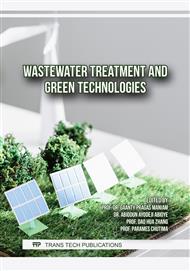[1]
E. Vetrimurugan, B. Karthikeyan, E. Lakshamanan, O.M. Ndwandwe, Human exposure risk to heavy metals through groundwater used for drinking in an intensively irrigated river delta, Applied Water Science, 7(6) (2017) 3267-3280.
DOI: 10.1007/s13201-016-0472-6
Google Scholar
[2]
Y. Li, Z. Xu, H. Ma, A. S. Hursthouse, Removal of Manganese(II) from Acid Mine Wastewater: A Review of the Challenges and Opportunities with Special Emphasis on Mn-Oxidizing Bacteria and Microalgae, Water, 11(12) (2019) 2493.
DOI: 10.3390/w11122493
Google Scholar
[3]
D. S. Patil, S. M. Chavan, J. U. K. Oubagaranadin, A review of technologies for manganese removal from wastewaters, Journal of Environmental Chemical Engineering, 4(1) (2016) 468-487.
DOI: 10.1016/j.jece.2015.11.028
Google Scholar
[4]
S. Lapwanit, T. Sooksimuang, T. Trakulsujaritchok, Adsorptive removal of cationic methylene blue dye by kappa-carrageenan/poy)glycidyl methacrylate) hydrogel beads: preparation and characterization, Journal of Environmental Chemical Engineering, 6(5) (2018) 6221-6230.
DOI: 10.1016/j.jece.2018.09.050
Google Scholar
[5]
P. S. Araujo, G. B. Belini, G. P. Mambrini, F. M. Yamaji, W. R. Waldman, Thermal degradation of calcium and sodium alginate: A greener synthesis towards calcium oxide micro/nanoparticles, International Journal of Biological Macromolecules, 140(1) (2019) 749-760.
DOI: 10.1016/j.ijbiomac.2019.08.103
Google Scholar
[6]
R. S. Fernandes, M. R. Moura, G. M. Glenn, F. A. Aouada, Thermal, microstructural and spectroscopic analysis of Ca2+ alginate clay nanocomposite hydrogel beads, Journal of Molecular Liquids, 265(1) (2018) 327-336.
DOI: 10.1016/j.molliq.2018.06.005
Google Scholar
[7]
E. Eren, B. Afsin, Y. Omal, Removal of lead ions by acid activated and manganese oxide-coated bentonite, Journal of Hazardous Materials, 161(2) (2009) 677-685.
DOI: 10.1016/j.jhazmat.2008.04.020
Google Scholar
[8]
A. M. Muliwa, T. Y. Leswifi, A. Maity, A. Ochieng, M. S. Onyango, Fixed-bed operation for manganese remova from water using chitosan/bentonite/MnO composite beads, Environmental Science Pollutant Research, 25(18) (2018) 18081-18095.
DOI: 10.1007/s11356-018-1993-3
Google Scholar
[9]
E. Makhado, M. J. Hato, Preparation and characterization of sodium alginate based oxidized multi-walled carbon nantotubes hydrogel nanocomposite and its adsorption behavior for methylene blue dye, Frontiers in Chemistry, 9 (2021).
DOI: 10.3389/fchem.2021.576913
Google Scholar



